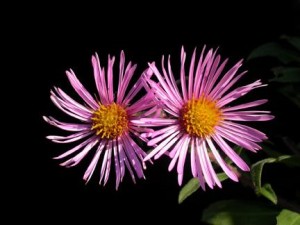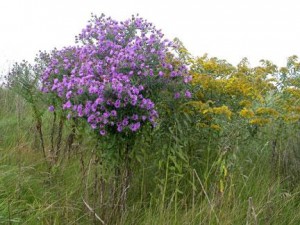The Stars of Autumn
- Share
- Tweet
- Pin
- Share
There soon will be a widely blooming wildflower, often quite subtle but attractive, that signals the end of the flowering season, like the final act of the fall play. You could call them the stars of autumn, the asters. In fact their name in Greek means “star,” and legend indicates that this wildflower was the chosen plant of John Alden and Priscilla of early New England days.
Asters are primarily North American flowers with around 150 species found here; they grow sparingly elsewhere in the world. Canada has about 60 to 70 species, while Europe and Russia each sport 10. What’s so exciting about the asters is that they can be found in so many different habitats ranging from wetlands to prairies, deciduous to evergreen woods and from practically desert environments to cold wet bogs.
These conspicuous widespread plants are largely perennials ranging in color from white to blue, lavender, pink, purple and hosts of intermediate shades. Unfortunately the color of some species is not uniform and may vary, for example from lavender to white, making for difficult identification.
Not only are these popular wildflowers highly variable, they also are known to cross with other wild aster species. You may have to dissect the disc of an individual flower and then use a good hand lens and ruler to examine and measure parts of the disc flowers for accurate identification. I have usually been quite content to simply refer to the asters as white, blue, purple, etc., my primary concern being to enjoy the exquisite color combinations of these blossoms to their fullest.
Two of my favorites are the Bog Aster, Aster nemoralis (nem-o-RAY-lis) and the Red or Purple-stemmed Aster, Aster puniceus (pew-NISS-e-us), the latter having hairy reddish stems. I’ve marveled at some of the Red-stemmed Asters that were around six feet tall, among the taller species of our region. They often grow in patches in swamps, wet meadows or along stream banks. Check to see how the leaves clasp the stems. One of the most widely planted and showy asters is the New England Aster, A. novae angliae (NO-vee-ANG-lee-ee), meaning “of New England.” Strangely this highly admired aster is actually quite uncommon in New England!
Even though many asters are late-blossoming plants, they produce seeds rapidly that are usually spread by the wind over the countryside, often over the shallow crusty snow of early winter.
All of the asters are quite sensitive and do poorly after being picked. In fact many of the flower heads close shortly after they have been gathered. Like so many other wildflowers, they are best admired, photographed, and studied where they grow.
Upon examining a blossom you will find that it is made up of thin, outer, strap-shaped ray flowers and a closely packed central cluster of disc flowers. So in reality what is referred to as one flower is actually many individual flowers, a genuine composite. Pick an aster blossom, carefully pull it apart down the center and you can easily examine the individual parts. With aster plants being so numerous throughout the countryside, this might provide students with some excellent beginning botany lessons.
Each ray flower consists of what is normally called a petal. Attached to the inner end and angled upward is a small Y-shaped stigma. Fastened to the inner end of the ray flower (which is a pistillate or female flower) but angled downward, is the ovary. When fertilized it will produce a fruit, usually erroneously referred to in this case as a seed.
The central part of the flower, the cluster of staminate disc flowers, is usually yellow at first but turns reddish as the flower ages. Each tubular disc flower contains a thin Y-shaped stamen. Nectar is found in the tubes and can be reached by long-tongued insects such as bumblebees and butterflies. The New England Asters I have studied in the past invariably had numerous honeybees actively gathering pollen from the disc flowers.
A small number of animals, including the Ruffed Grouse, American Tree Sparrow, Cottontail and even White-tailed Deer are known to occasionally make use of the “seed” heads as food.
An aster blossom is quite attractive when viewed from the side. The pointed bracts overlap in several circles and form what appears as a long tapered green receptacle from which the blossom grows. Outer bracts are shorter than the inner ones. Collectively they make up what is called the involucre (in-vo-LEW-cur) of the blossom.
How ideal it would be to be able to provide each of you readers with a flowering aster plant to carefully examine as you read this story, paragraph by paragraph. Better yet, take the story with you afield for some learning on the spot!
It quite easily becomes apparent that many species of asters can be very invasive. In other words, use caution in introducing some to your flower garden. There is a relatively newly introduced roadside plant, resembling a small bushy white daisy which I hope to identify, that grows very abundantly, or even aggressively, in solid stretches along some roadsides in our county, particularly some of the state highways. I shudder to think of this plant, daisy or not, getting loose and invading field after field here.
Galaxy by galaxy, the asters will soon decorate the meadows and roadsides in beautiful constellations. They await your discovery and enjoyment, and for each new species you positively identify, you may award yourself with a star!



